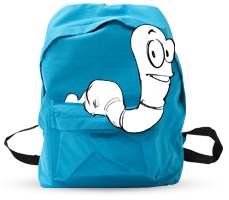The whipworm, appropriately named for its unique whip-like shape1, is a parasite which can infect both children and adults, and can even cause intestinal disease if not identified and treated properly. While this type of infection have been reported across the globe, they're overwhelmingly more prevalent in countries with warm, humid climates, high population density and poor hygiene and sanitation standards. A whipworm infection in Australia or New Zealand is considered very rare indeed – but we know that all parents love to be prepared when it comes to the health and wellbeing of their family. Here's our factsheet on things related to whipworms, including how to identify a worm infection and how to get rid of one.
If, based on the information here, you believe your child or a member of your family might have contracted a whipworm infection, seek medical attention immediately.
How are whipworms caught?
Whipworm infections are transmitted through the faeces of infected individuals, which contains eggs2. The faeces which is passed can also end up being used as fertilizer, especially in some countries where sanitation is poor – and if these food items aren't carefully washed, peeled and cooked, the eggs or larvae can end up being ingested, which kick-starts the infection cycle all over again.
However, it's important to remember that whipworm infections are rare in Australia and New Zealand, and it's therefore unlikely that children in this region could contract such infections on home soil.
What are the symptoms of a whipworm infection?
A light infection can have no signs or symptoms3 whatsoever; however some people may experience abdominal pain, diarrhoea or anaemia4. Those who contract a particularly heavy infection can experience painful passage of stool, rectal problems and even impaired cognitive development in children5.
Find out more about the symptoms of worms
How can I prevent whipworm infections?
Always teach children to wash their hands with soap and warm water before they handle food or put their fingers in their mouth. Teaching children the importance of staying away from faecal matter outdoors is also a great way to reduce the risk of contracting this infection– as rare as it may be in Australia and New Zealand. If you regularly eat fruits and vegetables that have been fertilized with manure, it's also vital to wash, peel and cook them thoroughly and properly before eating.
What can I do if I think my child has a whipworm infection?
If you think your child or any other member of your family might have contracted whipworm, see a medical professional immediately for further treatment and advice. Health care professionals6 can normally diagnose whipworm from a stool sample, where they look for eggs using a microscope.
Find out more about worms in Children
[1] http://parasite.org.au/para-site/text/trichuris-text.html
[2] http://www.wormtreatment.com/dyn/286/Whipworm.html
[3] https://www.cdc.gov/parasites/whipworm/gen_info/faqs.html
[5] http://parasite.org.au/para-site/text/trichuris-text.html
[6] http://www.cdc.gov/parasites/whipworm/gen_info/faqs.html



